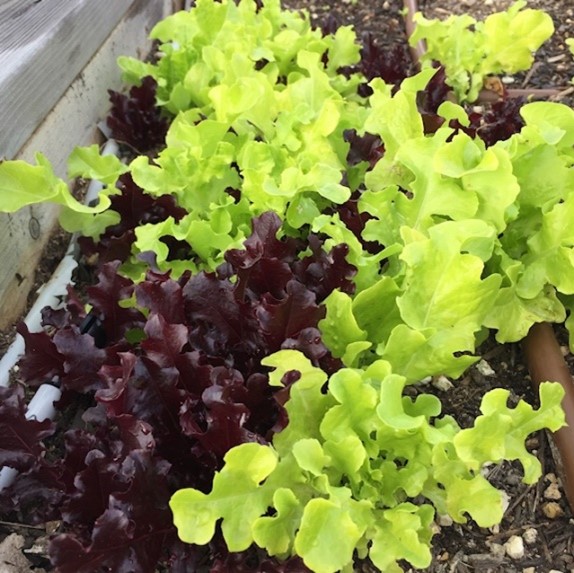By Michelle Hobbs, Bexar County Master Gardener

If you love having something fresh to harvest from the garden during the coldest parts of the year, lettuce is a great choice. It is easily started by seed and there is a large variety of seeds available at your local garden nursery or at on-line seed companies.
You can be successful growing leafy, butterhead and Romaine lettuces. Iceberg lettuce (and other head lettuce varieties) generally grow better in cooler climates than in Texas.
While I do grow some specific lettuce varieties, I tend to have the best results growing lettuce mixes. I also love the look of different leaf shapes and colors in a salad. Many local seed companies have a great selection of lettuce mixes.
Lettuce is easy to grow if you follow these basics:
Timing: This is the most critical element. If planted when temperatures are too warm, your lettuce will quickly become bitter, send up a stalk (called bolting), and go to seed. Of course, these seeds may be saved for new plants in the spring.
In the Hill Country, you should start your seeds outdoors between August 1st and September 30th; in San Antonio, ideally you should start your seeds between August 20th and October 10th.
In the heat of late summer, it can be challenging to keep the soil at the right moisture and temperature levels when direct seeded into the garden. Since it can still be quite warm at this time, it is helpful to use shade cloth to keep the full sun off your new plants. If you are growing your lettuce in pots, ensure that your plants are kept out of the hot afternoon sun. As it gets colder, you will want to cover your lettuce if temperatures are predicted to drop below freezing.

Seed starting indoors: While lettuce may be direct seeded in the garden, I find that it is easiest and that I have the best results when starting seeds indoors in a seed starting medium. Any small, well-draining container is acceptable and the small lettuce seeds will need light to germinate. Once the seeds germinate, typically in a couple of days, keep the seedlings in a sunny south–facing window or ideally under a grow light. The small plants can be transplanted outside after 4 weeks. The plants will need to be gradually acclimated to the outdoor conditions before being planted in the garden. Putting shade cloth over the new plants may also help with the transition.
Sun: Lettuce does best when it doesn’t have full sun, particularly the afternoon sun, when temperatures are still in the 80’s. When the weather starts to cool, full sun is good.
Soil: Lettuce can be grown in pots or raised beds, using a quality potting mix amended with compost, or directly in the ground, in soil that is loose and enhanced with organic matter (such as compost).
Fertilizer: Lettuce does not require a high level of fertilization, but I do ensure that I have a timed- released fertilizer in the planting bed prior to planting, and every couple of weeks I will water with a liquid fertilizer. If growing lettuce in pots, a good quality liquid fertilizer should be sufficient.
Water: Lettuce is very shallow-rooted and will need to be watered frequently.
Harvesting: One benefit of leafy type lettuces is that in addition to harvesting the entire plant, the outside leaves of the plant may be harvested, and the leaves will grow back for another cutting. It is important to harvest your lettuce early in the morning when the maximum amount of water is in the leaves. If you harvest later in the day, the leaves will quickly wilt due to evaporation. I use a pair of small pruning shears, cut leaves from the outside of the plant and immediately wrap them in a damp paper towel. I quickly bring them inside, rinse the leaves in cool water and put them in the refrigerator.
Pests: Fortunately lettuce tends to have fewer pests than many vegetables, but you must stay diligent if you do notice a pest. The biggest problems are cabbage loopers, army worms and other types of worms that can be easily controlled by using an organic product that contains BT (Bacillus Thuringiensis).
For beginning gardeners and those who have limited time and space, lettuce is a great vegetable to add to your garden or patio. For further resources see Fall Vegetable Gardening Guide: EHT-056.pdf (tamu.edu)
Photos by Author
